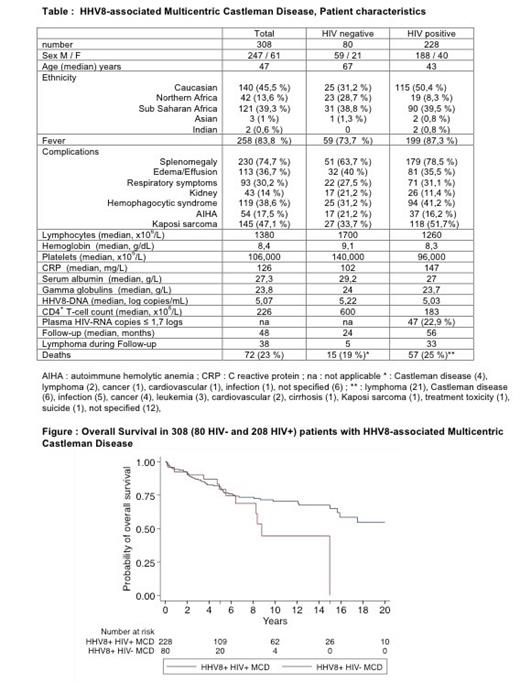Introduction : KSHV/HHV-8 associated multicentric Castleman disease (HHV-8 MCD) is a rare lymphoproliferative disorder associating lymphadenopathy, splenomegaly, fever and inflammatory symptoms with high serum CRP, hypergammaglobulinemia and high plasma HHV-8 DNA viral load. HHV-8 MCD mainly affects HIV infected patients but can also be observed in HIV negative patients born in countries with high HHV-8 prevalence or in men who have sex with men. In a large cohort of HIV negative patients, we sought to describe patient and disease characteristics and to compare them with those observed in a large cohort of HIV-infected patients with HHV8 MCD.
Methods : We analysed a cohort of 80 HIV negative patients with HHV8+ MCD and compared them to 228 HIV-infected patients with HHV8+ MCD. These patients have been prospectively enrolled in the national registry for Castleman disease held by the Reference Center for Castleman Disease in Paris, over a 30-year period.
Results : Most of these patients (67,5 %) originated from Sub saharan or Northern Africa. The baseline characteristics were similar in HIV- and HIV+ patients although HIV negative patients were older at MCD diagnosis (median, 67 vs 43 years) with 20% of the patients above 75 years, and the male predominance was slightly lower in the HIV negative population (74% vs 82%). They also presented less frequently with previous Kaposi sarcoma lesions (34% vs 52%). Biological markers including cytopenia, serum CRP and gamma globulins levels as well as blood HHV8 DNA viral load were very similar in both groups, although MCD attacks in HIV negative patients were rather less agressive than in HIV-infected patients. Of notice, the median CD4 + T cell count was normal in the HIV negative group (600 x10 6/L)
The incidence of lymphoma during follow-up remains high but very similar in both groups : 3,12 /100 pt.y. in HIV negative patients and 3,10 /100 pt.y. in HIV-infected patients
The median overall survival (OS) was 8,8 years (95%CI, 5,5-15) in HIV- patients and 20,6 years (95%CI, 6,3-24,1) in HIV-infected patients (p=0.19). Although the follow-up was shorter in HIV negative patients (24 vs 56 months), the 5-year probability of survival (79,2%; 95%CI 61,7-89,4) was very similar to that observed in HIV-infected patients (81,2% ; CI95% 74,6-86,2). Death was related to HHV8 complications or treatment in 6 /15 (40%) HIV negative patients and in 31 /57 (54%) HIV-infected patients. The slightly higher proportion of deaths not related to HHV8 in the HIV negative population might be explained by the older age of these patients.
Conclusions : Using a large cohort of HIV negative patients, we could show that HHV8 MCD in this population is very similar to that observed in HIV-infected patients. Despite the fact that these patients were older at diagnosis, the overall survival was similar to that observed in HIV-infected patients, at least at 5-year from diagnosis.
Disclosures
Galicier:EUSAPHARMA: Consultancy; AMGEN: Consultancy. Meignin:EUSAPHARMA: Consultancy. Oksenhendler:EusaPharma: Consultancy; CSL Behring: Consultancy.


This feature is available to Subscribers Only
Sign In or Create an Account Close Modal